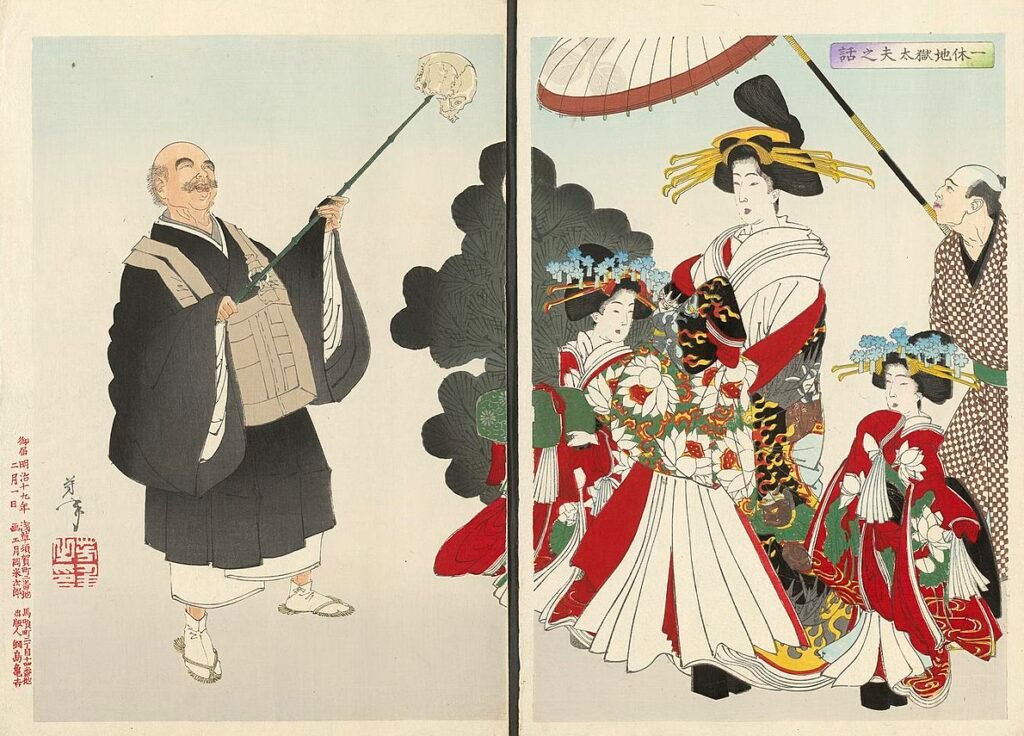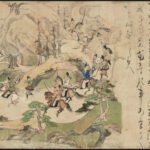Anyone familiar with Japanese art has likely encountered the enigmatic figure known as Hell Courtesan (Jigoku Tayu). This legendary courtesan from the Muromachi period (1336-1573) continues to captivate audiences through her distinctive name and the mesmerizing portraits created by numerous ukiyo-e artists. This article explores the life of Hell Courtesan (Jigoku Tayu) and examines her enduring influence on Japanese culture.
Who Was Hell Courtesan (Jigoku Tayu)?
The Origin and Meaning of Her Name
Hell Courtesan, known in Japanese as Jigoku Tayu (地獄太夫), can be romanized in various ways: Jigoku Tayu, Jigoku tayuu, or Jigoku tayū. The name carries profound dual meanings that reflect the complexity of her existence.
In the Japanese pleasure quarter hierarchy, “Tayu” represented the highest rank of courtesan—women who were not merely prostitutes but accomplished artists, poets, and entertainers who commanded respect and substantial fees. The term “Jigoku” (hell) held multiple connotations: while it literally meant the Buddhist concept of hell, in Edo period slang, it also referred to the lowest class of streetwalkers. This ironic juxtaposition in Hell Courtesan (Jigoku Tayu)’s chosen name reveals her philosophical depth and self-awareness.
A Tragic Journey: From Samurai Daughter to Courtesan
Hell Courtesan (Jigoku Tayu) was born into the samurai class as the daughter of Umezu Kamon Kagekaru, with the childhood name Otoboshi. Her privileged upbringing came to an abrupt end when bandits captured her at Mount Nyoi. Due to her extraordinary beauty, instead of meeting a worse fate, she was sold into prostitution and eventually came under the patronage of a wealthy merchant in Sakai, Osaka (specifically in what is now Takasu-cho, Sakai-ku, Sakai City).
Faced with this devastating turn of fortune, she developed a unique philosophical perspective. She believed that “misfortune in this life results from poor spiritual discipline in previous lives”—a Buddhist concept of karma. Embracing this belief, she deliberately adopted the name “Jigoku” (Hell) and began wearing elaborate kimonos embroidered with scenes from Buddhist hell. While reciting Buddhist prayers in her heart, she would sing elegant songs, creating a striking contrast that fascinated all who encountered her. This unusual combination of beauty and macabre imagery quickly made Hell Courtesan (Jigoku Tayu) one of the most talked-about figures in the pleasure quarters.
The Fateful Encounter with Ikkyu Sojun
A Battle of Wits Through Poetry
The true brilliance of Hell Courtesan (Jigoku Tayu) emerged during her legendary encounter with Ikkyu Sojun (1394-1481), an eccentric Zen monk famous for his love of sake and frequenting of pleasure quarters. When Ikkyu visited Sakai (some accounts suggest he came specifically to meet her), she noticed him and initiated their famous poetic exchange.
She composed:
“山居せば深山の奥に住めよかし ここは浮世のさかい近きに”
Yama-i seba miyama no oku ni sume yo kashi / koko wa ukiyo no sakai chikaki ni
This seemingly simple verse, which superficially means “If you choose mountain dwelling (monastic life), you should live deep in the mountains—this place is too close to the floating world’s boundary,” contains clever wordplay. “Sakai” refers both to the city of Sakai (then a major commercial hub) and to “boundary,” while “floating world” (ukiyo) was a euphemism for the pleasure quarters. Essentially, Hell Courtesan (Jigoku Tayu) was provocatively asking why a supposedly worldly-detached monk was visiting a brothel.
Ikkyu responded with characteristic Zen nonchalance:
“一休が身をば身ほどに思わねば 市も山家も同じ住処よ”
Ikkyu ga mi wo ba mi hodo ni omowaneba / ichi mo yamaga mo onaji sumika yo
His reply embodied the Zen concept of emptiness (ku): “Since I think nothing of this body, the marketplace and mountain hermitage are equally home to me”—or more bluntly, “I’ll go wherever I please.”
Mutual Recognition and Admiration
Upon realizing this courtesan was the famous Hell Courtesan (Jigoku Tayu), Ikkyu composed:
“聞きしより見て恐ろしき地獄かな”
Kikishi yori mite osoroshiki jigoku kana
While this literally translates to “Hell is far more terrifying to see than to hear about,” the verse plays on her name. Since “terrifying” in this context refers to her legendary beauty and accomplishments, Ikkyu was essentially saying, “You’re even more beautiful and impressive than your reputation suggests.”
Hell Courtesan (Jigoku Tayu) responded with another witty verse:
“しにくる人のおちざるはなし”
Shi ni kuru hito no ochizaru wa nashi
This line brilliantly interweaves Buddhist doctrine with sensual innuendo: “All who come to die fall into hell” also means “All who come to me for pleasure fall for me.” She was essentially warning, “If you intend to proceed, you’d better be prepared for the consequences.”
This remarkable exchange reportedly led to a master-disciple relationship between the unconventional monk and the philosophical courtesan.
Consolation and Enlightenment
Their relationship deepened beyond clever wordplay. When Hell Courtesan (Jigoku Tayu) once lamented, “If only I could renounce the world and serve Buddha, perhaps I could find salvation,” Ikkyu consoled her by saying, “You who sell your five-foot body to ease the desires of sentient beings surpass corrupt Zen monks.”
Some accounts attribute the famous death poem “門松は冥土の旅の一里塚めでたくもありめでたくもなし Kadomatsu wa meido no tabi no ichiri-zuka / medetaku mo ari medetaku mo nashi” (New Year’s pine decorations are milestones on the journey to the afterlife—both auspicious and inauspicious) to Ikkyu’s correspondence with Hell Courtesan (Jigoku Tayu), though this attribution remains debated.
Final Days and Memorial
Hell Courtesan (Jigoku Tayu) died young, leaving behind the death poem: “Ware shinaba yaku na uzumu na no ni sutete / uetaru inu no hara wo koyase yo” (When I die, don’t burn me, don’t bury me—throw me in the fields to fill the bellies of starving dogs).
Ikkyu, who attended her deathbed, reportedly built a memorial mound at Kumeda-dera temple in Yagi-go, Senshu (present-day Osaka). He remained Hell Courtesan (Jigoku Tayu)’s spiritual mentor until the end. However, scholars note that many of these anecdotes may be later embellishments rather than historical fact.
Hell Courtesan (Jigoku Tayu) in Ukiyo-e Art
The Iconography of Hell Courtesan (Jigoku Tayu)
The striking figure of Hell Courtesan (Jigoku Tayu) inspired countless ukiyo-e artists, who found in her a subject that perfectly embodied the paradoxical nature of beauty and mortality. Her visual representation in these woodblock prints follows distinctive iconographic conventions that make her instantly recognizable.
Typically, Hell Courtesan (Jigoku Tayu) is depicted wearing elaborate kimono decorated with imagery from Buddhist hell realms. These garments feature:
- Scenes of Buddhist hell with tortured souls
- The imposing figure of Emma-O (King Yama), the judge of the dead
- Horned demons wielding instruments of torture
- Compassionate bodhisattvas offering salvation
What makes these depictions particularly fascinating is the juxtaposition of terrifying hell imagery with the courtesan’s serene beauty. In works by Kawanabe Kyosai, her robes sometimes feature Hotei (one of the Seven Lucky Gods) in the guise of Jizo, the bodhisattva who protects children, travelers, and souls in the underworld. Other artistic elements include karako (Chinese child motifs symbolizing family prosperity), often shown stacking jewels—a visual metaphor for accumulating merit in the Buddhist tradition.
Major Novel and Artistic Works
Santo Kyoden’s “Honcho Sui Bodai Zenden” (1809)
The first Toyokuni, a major ukiyo-e master, created illustrations for Santo Kyoden’s novel “Honcho Sui Bodai Zenden” (Complete Tales of Drunken Enlightenment in Our Country). This work presents a pivotal scene in the Hell Courtesan (Jigoku Tayu) legend: when Ikkyu visits the pleasure quarters and dances with geisha, they suddenly transform into skeletons. Witnessing this supernatural event, Hell Courtesan (Jigoku Tayu) realizes Ikkyu is no ordinary monk and receives his teaching, ultimately achieving enlightenment.
This narrative draws from two sources: the oral traditions surrounding Hell Courtesan (Jigoku Tayu) that circulated during the Edo period, and “Ikkyu’s Skeletons,” an illustrated religious text that uses skeleton imagery to convey the Buddhist teaching that living and dead beings are essentially the same. Kyoden and Toyokuni synthesized these elements to create their compelling visual narrative.
Kawanabe Kyosai’s “Hell Courtesan and Ikkyu”
Kawanabe Kyosai represents a unique figure in Japanese art history. He began his artistic training under the ukiyo-e master Utagawa Kuniyoshi before receiving formal instruction in the orthodox Kano school techniques at Surugadai. This dual training enabled him to navigate the tumultuous transition from the Edo to Meiji periods, when many traditional artists struggled as their samurai patrons lost power.
His monumental work “Hell Courtesan and Ikkyu” demonstrates his masterful synthesis of popular and classical traditions. Executed on a large scale with meticulous detail, the painting depicts Hell Courtesan (Jigoku Tayu) alongside Ikkyu as he dances with skeletons. While the subject matter derives from Edo popular culture, Kyosai’s technical execution reflects his rigorous classical training.
Kawanabe Kyosai’s “Portrait of Hell Courtesan”
Another masterpiece by Kyosai shows Hell Courtesan (Jigoku Tayu) in contemplative repose, resting her cheek on a metal staff while skeletons dance around her. Emma-O peers out from the hem of her robe, and a weeping young girl crouches at her feet. This composition brilliantly captures the work’s thematic tensions: the decadent beauty of a woman wrapped in hellish imagery, the stark contrasts between male and female, old and young, beautiful and grotesque. The dynamic, naturalistic rendering of the dancing skeletons showcases why Kyosai earned his reputation as the master of “mad pictures” (kyoga).
Tsukioka Yoshitoshi’s “Hell Courtesan Attaining Enlightenment”
From his series “New Forms of Thirty-Six Ghosts,” Yoshitoshi’s interpretation captures the moment of Hell Courtesan (Jigoku Tayu)’s spiritual awakening. Known for his dramatic compositions and psychological depth, Yoshitoshi presents her with an expression of mystical transformation, masterfully visualizing the internal journey from suffering to enlightenment.

Hell Courtesan (Jigoku Tayu) represents a unique figure in Japanese cultural history. Born a samurai’s daughter, sold into prostitution, yet transforming her circumstances into a path of spiritual inquiry, she embodies the possibility of finding meaning and beauty even in the most difficult circumstances. Her story has inspired artists for centuries, each generation finding new relevance in her tale.
Whether the historical details of her encounters with Ikkyu are factual or legendary matters less than what these stories reveal about Japanese cultural values. The enduring fascination with Hell Courtesan (Jigoku Tayu) speaks to a aesthetic philosophy that transcends simple dualities of good and evil, finding profound beauty in life’s contradictions.
In contemporary times, Hell Courtesan (Jigoku Tayu) continues to resonate as a symbol of resilience and transcendence. Her story suggests that regardless of circumstances, individuals can pursue spiritual growth and create beauty from suffering. Perhaps she teaches us to look beyond surface judgments of morality and aesthetics to perceive deeper truths about human existence.
The visual representations of Hell Courtesan (Jigoku Tayu) in ukiyo-e are more than portraits of a beautiful woman. They embody a distinctly Japanese aesthetic sensibility that embraces contradiction—finding beauty in the coexistence of opposites. Her figure, draped in hellish imagery while maintaining a serene countenance, visualizes the fundamental Buddhist teaching that suffering and enlightenment, samsara and nirvana, are not separate realms but different perspectives on the same reality.
The enduring appeal of Hell Courtesan (Jigoku Tayu) lies not just in her legendary beauty or tragic circumstances, but in what she represents: the human capacity to transform suffering into wisdom, to find the sacred within the profane, and to create art from life’s harshest realities. As we continue to rediscover her through the masterworks of ukiyo-e, Hell Courtesan (Jigoku Tayu) remains a powerful reminder of art’s ability to transmute human experience into timeless beauty.
Whatever the historical truth behind the legend, Hell Courtesan (Jigoku Tayu) has secured her place as an immortal figure in Japanese culture—a profound symbol of the complex interplay between beauty and impermanence, desire and detachment, hell and enlightenment that characterizes the Buddhist understanding of existence. Through the centuries, artists have returned again and again to her image, finding in Hell Courtesan (Jigoku Tayu) an inexhaustible source of inspiration for exploring the deepest paradoxes of the human condition.
References
- Wikipedia Entry: “Jigoku Dayu” (Japanese language source providing biographical details)
- President Art Column: “Chapter 12: Hell Courtesan and Ikkyu” – Explores the relationship between the courtesan and the Zen monk
- Academic Paper: “Costume Patterns in Kawanabe Kyosai’s ‘Portrait of Hell Courtesan‘” Detailed analysis of the symbolic meanings in kimono designs
- National Diet Library Digital Collection: “New Forms of Thirty-Six Ghosts: Hell Courtesan Attaining Enlightenment”






